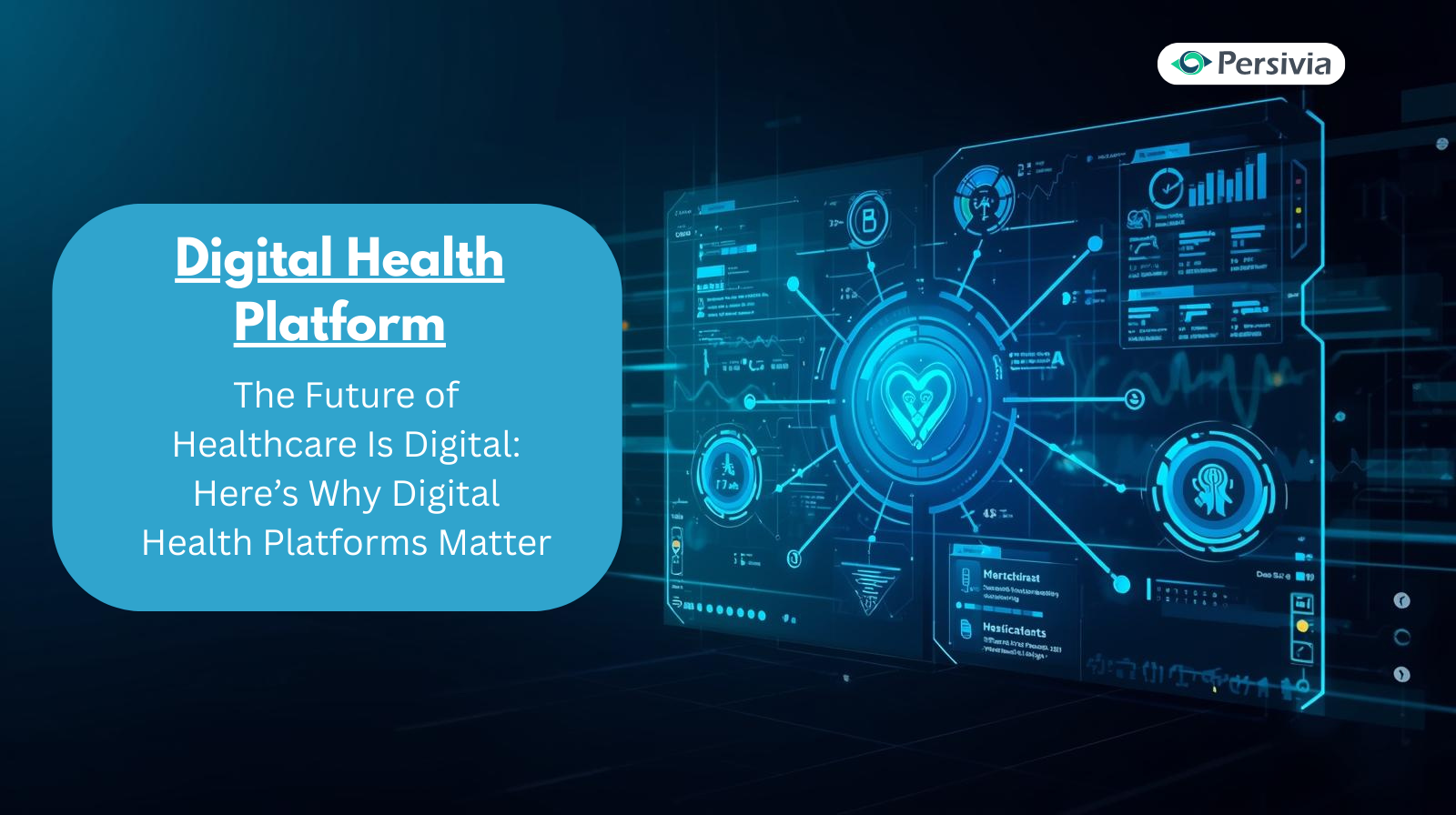Healthcare is becoming proactive rather than reactive. Paper records, isolated systems, and slow decision-making on care are becoming a thing of the past. A Digital Health Platform is a digital platform that currently forms the foundation of contemporary healthcare delivery that providing an interface between providers, payers, and patients, making use of smart technology. These platforms do not simply store data; they work to convert it into actionable insights that enhance the quality of care, lower the costs, and simplify operations.
This has been hastened by the emergence of Healthcare AI. Hospitals have challenges of disjointed data in various systems. There should be improved methods of tracking quality metrics by payers. Providers desire real-time patient data at the point of care. An integrated digital health will solve these issues by encompassing them all into a single integrated ecosystem. This change is no longer a choice; it is now a must-have requirement for organizations that would like to succeed in a value-based care model.
A digital health platform is a combination of technologies that consolidate, administer, and calculate healthcare information among various sources. It links electronic health records, claim systems, and lab results with patient-generated data to a single interface.
These platforms serve three core functions:
- Data aggregation: Pulling information from disparate sources into a single database
- Analytics and insights: Using AI to identify care gaps, risk factors, and improvement opportunities
- Workflow automation: Streamlining administrative tasks and clinical decision-making
The site serves as a central nervous system to healthcare organizations. When a physician opens a patient’s chart, he/she will view the medication history, the latest laboratory results, specialist notes, and the quality measure status all on a single screen.
There is a fundamental change that is experienced in the healthcare landscape. Models of value-based care compensate based on rewards other than volume and necessitate real-time insight into patient groups and automated tracking of quality. These demands can not be fulfilled using manual processes, particularly when it comes to an organization dealing with thousands of patients and various quality measures.
Fee-for-service is giving way to arrangements where providers earn based on patient outcomes. Medicare Advantage plans must meet STAR rating benchmarks. ACOs track quality measures that determine shared savings.
These models require:
- Real-time visibility into patient populations
- Automated identification of care gaps
- Coordinated care across multiple providers
- Accurate risk stratification and HCC coding
To supervise hundreds of quality measures per patient, a practice that manages 10,000 Medicare Advantage patients must monitor. This tracking is computer-assisted by Digital Health, which promptly identifies patients requiring interventions to prevent the quality score from being impacted by the gaps.
The average hospital uses 16 different software systems. Each disconnected system creates inefficiency:
- Staff spend hours collecting information from multiple sources
- Providers miss critical patient history during visits
- Duplicate tests occur because the results aren’t accessible
- Care coordination breaks down between settings
A unified platform eliminates these problems through one system, one login, and one source of truth.
Contemporary digital health systems are constructed around four interrelated elements that effectively collaborate to revolutionize care delivery. The components are specific to the operations, and they enhance the intelligence and efficiency of the entire ecosystem.
The foundation handles data from any source:
- Direct EHR integrations using HL7 and FHIR standards
- Claims feed from payers and clearinghouses
- Lab interfaces for real-time results
- Patient portals capturing self-reported data
The platform doesn’t just collect information normalizes it. A blood pressure reading from one EHR looks different than the same reading from another system. The data platform translates everything into a common format so analytics work correctly.
Population health shifts focus from individual patients to entire groups. The platform segments populations by chronic condition type, risk score, and predicted future costs, quality measure gaps, and social determinants affecting health outcomes.
The platform has some clinical programs that drive the delivery of care. A care map of managing diabetes also consists of appointment books, laboratory orders, medication regimens, and patient education resources. Healthcare AI improves these programs through the prediction of patients who are likely to develop complications so that preventive measures can be taken before the issue arises.
Artificial intelligence powers multiple platform functions:
- Predictive analytics: Identifying patients at risk for hospital readmission or disease progression
- Natural language processing: Extracting insights from clinical notes and documentation
- Workflow automation: Routing tasks to appropriate team members based on patient needs
- Quality measure calculation: Automatically determining HEDIS and STAR rating performance
The AI uses these historical data trends, as it is aware that there are patients with some features that are prone to certain complications. Through this knowledge, proactive outreach and early intervention occur.
The insights would not mean everything unless providers have access to them at the point of contact with patients. Point-of-care tools provide full summaries of patients, including their recent history, current care gaps that need to be addressed, risk scores, predictive notifications, and suggested treatments.
These tools are intrinsically built into clinical workflows in both directions with bi-directional EHR connectivity. At the EHR, a doctor can get notifications about the missed screenings. One click opens the platform’s detailed view. Another click sends recommended orders back to the EHR, no system switching, no disrupted workflow.
In healthcare organizations, success is determined by certain quality and financial indicators. Digital platforms enhance these indicators systematically by providing automated tracking, intelligent prioritization, and enabling providers at the point of care.
Medicare Advantage plans live and die by STAR ratings. Higher ratings mean larger bonus payments from CMS, increased member enrollment, and better competitive positioning.
Digital platforms improve STAR performance through:
- Measure tracking: Monitoring all 40+ STAR measures for every member
- Outreach prioritization: AI ranking members by impact potential
- Provider enablement: Point-of-care alerts during routine visits
Hierarchical Condition Categories determine Medicare Advantage payments. Accurate coding means appropriate reimbursement. Missed diagnoses mean lost revenue, potentially thousands per patient annually.
Platforms improve HCC capture by:
- Analyzing historical claims to identify chronic conditions
- Prompting providers to document conditions during visits
- Using NLP to scan clinical notes for undocumented diagnoses
- Automating suspecting condition workflows for validation
HEDIS measures assess health plan quality. Commercial plans and Medicaid MCOs report these metrics to NCQA. Performance affects accreditation status, employer group contracts, and public quality ratings.
CareSpace® addresses HEDIS systematically through multiple approaches:
| Challenge | Platform Solution | Impact |
| Measure complexity | Automated calculation across multiple criteria | Reduces manual errors |
| Member outreach | Risk-stratified campaigns targeting high-impact gaps | Increases engagement |
| Provider engagement | Real-time alerts during appointments | Improves capture rates |
| Documentation gaps | NLP extraction from unstructured notes | Recovers missing data |
In addition to quality indicators, online services change the way providers, payers, and care teams operate on a day-to-day basis. The enhancements cut across the board of healthcare delivery, including clinical decision-making, and improving the efficiency of administration.
Unnecessary utilization drives healthcare spending. Digital platforms reduce costs by:
- Identifying high-cost, high-risk patients for intensive case management
- Flagging overutilization patterns like frequent ER visits
- Facilitating transitions of care to prevent readmissions
- Enabling alternatives to high-cost settings
The average intervention produces its outcomes: The system recognizes patients who visit the ER frequently with non-emergency conditions. The care coordinators make contacts, assign the patients to primary care, and organize transportation services. ER visits decrease by 30-40% among the engaged patients.
Physician burnout stems largely from administrative burden. Integrated platforms reduce this burden:
- Clinical decision support guides without research time
- Automated quality documentation eliminates manual form-filling
- Single-patient views eliminate system switching
- AI-generated summaries distill complex histories
Comprehensive platform practices have a higher rate of physician satisfaction and reduced turnover. Instead of wasting time clicking on the computer, providers have more time interacting with the patient.
Administrative staff, care coordinators, and nurses benefit from streamlined workflows. Tasks are assigned based on patient needs, high-risk cases are prioritized through intelligent queues, and real-time dashboards highlight daily priorities, keeping operations organized and efficient.
The data generated by healthcare is in every location where the tests are performed in labs, scans are completed in imaging centers, specialists record the encounters, and pharmacies fill the prescriptions. In the absence of interoperability, this data remains locked up. A cardiologist doesn’t see the endocrinologist’s recent A1C result. Care decisions happen with incomplete information.
Modern platforms solve this through:
- HL7 and FHIR support for industry-standard protocols
- API connectivity for real-time data pulls
- Batch file processing for scheduled imports
Payers have claims data showing diagnoses, procedures, and prescriptions. Providers have clinical data with vitals, notes, and lab results. Together, they paint the full picture. This convergence enables clinical validation of claims-based diagnoses, identification of treatment gaps based on condition severity, and medication adherence tracking.
The Future of Healthcare Lies in Digital Integration
Healthcare should change to suit the increased demands of quality and efficiency. The manual processes and detached systems will not be able to keep pace. Digital Health Platforms that integrate data, automate processes, and deliver actionable information spur quantifiable outcomes, financial and patient satisfaction improvements. The actual challenge is the speed at which the organizations can change to remain competitive.
Persivia’s AI-powered CareSpace® platform unifies data management, population health, clinical programs, and point-of-care tools in one system. It delivers real-time insights that help healthcare organizations improve quality scores, optimize coding, reduce operational costs, and strengthen care delivery across all settings.
Q: Can digital health platforms integrate with my existing EHR system?
Yes, the current platforms are linked to all the significant EHR systems via common HL7 and FHIR interfaces. Such a bi-directional connectivity will enable the data to run seamlessly between the systems without interfering with the current workflow of the clinic or making the providers familiarize themselves with new documentation systems.
Q: How long does platform implementation typically take?
No, timelines of implementation are dependent on the complexity and scope of the organization. Simple configurations can be deployed within a span of 3-4 months, and complex implementations with several modules can take 612 months with user training and adoption stages.
Q: Do staff members need extensive technical training to use these platforms?
No, user-friendly interfaces need little training to use rudimentary functions. The majority of the care team members can become experts in 2-3 days of practice, and further assistance is possible with advanced features and specialized workflows.

